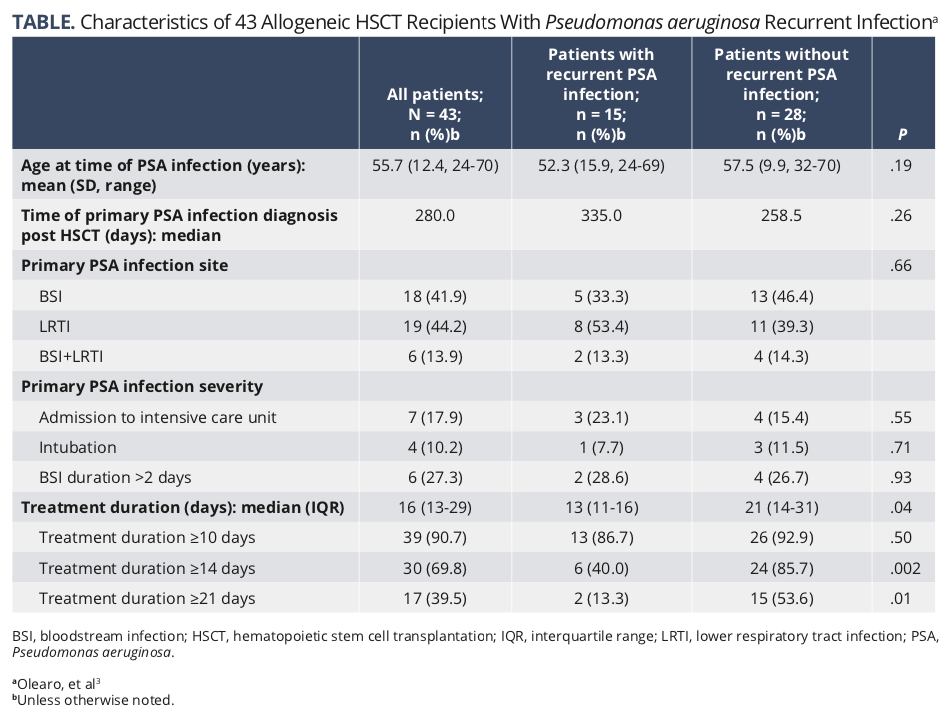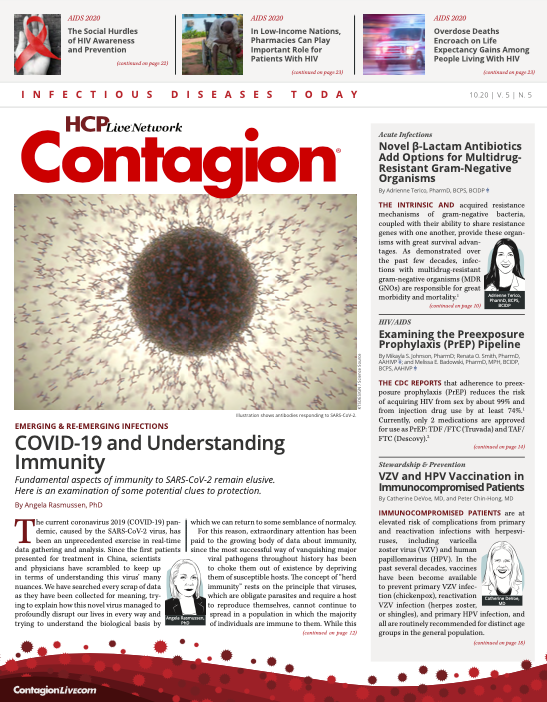When Shorter May Not Be Better: Pseudomonas Infection in Hematopoietic Stem Cell Transplant Recipients
Sara W. Dong, MD

Recent literature continues to suggest that shorter duration of antibiotics and stepdown to highly bioavailable oral agents may be appropriate for the treatment of gram-negative infections, in particular bacteremia. It is not clear, however, which patients may be poor candidates for shorter durations. There has been some general acceptance that Pseudomonas infections may require more aggressive therapy; many prior studies have focused primarily on relatively uncomplicated Enterobacterales infections. A randomized multicenter trial by Yahav, et al. found that a 7-day course was noninferior to a 14-day course in patients hospitalized with gram-negative bacteremia, but this included a small proportion of Pseudomonas infections, with 28 patients (9%) in the short 7-day arm and 20 (7%) in the longer 14-day arm. In addition, the number of immunocompromised patients was limited. Hematopoietic stem cell transplant (HSCT) recipients accounted for less than 2% of the total patients.1
A multicenter observational study by Fabre et al looked more closely at uncomplicated Pseudomonas bacteremia to determine whether short and prolonged courses of antibiotic therapy were associated with similar clinical outcomes. Authors noted that patients with short duration (median, 9 days) of therapy had similar odds of recurrent infection or death as those with longer courses (median, 16 days). The patient cohort also included more immunosuppressed patients than Yahav, et al. However, HSCT recipients were still limited to 9% (n = 6) and 15% (n = 27) in the short and prolonged course cohorts, respectively.2
In Open Forum Infectious Diseases, Olearo et al from the Swiss Transplant Cohort Study recently provided further examination of the outcomes of shorter antibiotic courses for Pseudomonas infections. This retrospective cohort study evaluated the incidence and timing of recurrent Pseudomonas aeruginosa (PsA) bloodstream infection (BSI) and/or lower respiratory tract infection (LRTI) in allogeneic HSCT recipients over an 8-year period.3 There was an overall 4.2% incidence rate (n = 55) of primary Pseudomonas aeruginosa infections in the 1314 allo-HSCT patients. Of these 55 patients, 22 (40%) had PsA BSI, 24 (44%) had PsA LRTI, and the remaining 9 (16%) had concomitant BSI/LRTI. The median duration of treatment for primary PsA infection was 15.5 days.
The primary outcome studied was recurrent Pseudomonas infection within 90 days of treatment completion. Twelve patients were excluded from the recurrent infection analysis due to death during treatment of primary infection or within 7 days of treatment completion. Further patient characteristics are noted in Table. Of the remaining 43 patients analyzed, 15 (35%) of the patients had recurrent Pseudomonas infection at a median of 28 days after treatment. Most of these (9/15; 60%) had recurrence within 30 days, and recurrent infection was observed equally among patients with primary BSI, LRTI, or concomitant infection.
Recurrence was more likely to occur in patients who received shorter treatment courses (median, 13 days vs 21 days). Recurrent infection was noted in 69% of patients who received fewer than 14 days of antibiotics and in 50% of those who received fewer than 21 days. The effect of treatment duration was also assessed by type of primary infection, and recurrent infections were more likely to occur in those with LRTI with treatment courses of fewer than 14 days. The only significant factor predictive against recurrent Pseudomonas infection in univariate analysis was longer duration (14 days or more) of treatment of primary infection (odds ratio [OR] for 14-21 days, 0.11; P =.004; OR for 22 or more days, 0.11; P = .02).
These results align with those of a prior study suggesting that there was increased risk of recurrence among HSCT patients with Pseudomonas bacteremia and/or pneumonia who received <14 days of antibiotics to treat the initial infection compared with those who received ≥14 days (32% vs 10%, respectively; P = .06).4 A prior systematic review of hospital-acquired pneumonia also noted that shorter courses of antibiotics were associated with recurrent infection in a subgroup of patients with ventilator-associated pneumonia (VAP) due to Pseudomonas and Acinetobacter.5 Subsequent meta-analyses were conflicting, with no difference noted in recurrence or mortality in subpopulations with VAP due to gram-negative infections. While the current Infectious Diseases Society of America clinical practice guidelines recommend a 7-day course of antibiotics for all pneumonias, both community- and hospital-acquired, certain infections in certain situations may nonetheless warrant longer duration.6 The study by Olearo et al provides further evidence supporting the idea that longer treatment courses may be required in allogeneic HSCT recipients with Pseudomonas infections, and this may be true in other immunocompromised hosts as well. Further research is needed to investigate what length of prolonged duration is most appropriate, but the results of this study should give pause in generalizing the use of 7-day antibiotic courses for bloodstream infection and pneumonia in those with prior HSCT or another immunocompromising condition.

Sara W. Dong, MD, is a combined adult and pediatric infectious diseases fellow at Beth Israel Deaconess Medical Center and Boston Children’s Hospital.
Highlighted study: Olearo F, Kronig I, Masouridi-Levrat S, et al; Swiss Transplant Cohort Study. Optimal treatment duration of Pseudomonas aeruginosa infections in allogeneic hematopoietic cell transplant recipients. Open Forum Infect Dis. 2020;7(7):ofaa246. doi:10.1093/ofid/ofaa246
References
1. Yahav D, Franceschini E, Koppel F, et al. Seven versus 14 days of antibiotic therapy for uncomplicated gram-negative bacteremia: a noninferiority randomized controlled trial. Clin Infect Dis. 2019;69(7):1091-1098. doi:10.1093/cid/ciy1054
2. Fabre V, Amoah J, Cosgrove SE, Tamma PD. Antibiotic therapy for Pseudomonas aeruginosa bloodstream infections: how long is long enough? Clin Infect Dis. 2019;69(11):2011-2014. doi:10.1093/cid/ciz223
3. Olearo F, Kronig I, Masouridi-Levrat S, et al; Swiss Transplant Cohort Study. Optimal treatment duration of Pseudomonas aeruginosa infections in allogeneic hematopoietic cell transplant recipients. Open Forum Infect Dis. 2020;7(7):ofaa246. doi:10.1093/ofid/ofaa246
4. Hakki M, Limaye AP, Kim HW, et al. Invasive Pseudomonas aeruginosa infections: high rate of recurrence and mortality after hematopoietic cell transplantation. Bone Marrow Transpl. 2007;39(11):687-693. doi:10.1038/sj.bmt.1705653
5. Pugh R, Grant C, Cooke RP, Dempsey G. Short-course versus prolonged-course antibiotic therapy for hospital-acquired pneumonia in critically ill adults. Cochrane Database Syst Rev. 2015;2015(8):CD007577. doi:10.1002/14651858.CD007577.pub3
6. Kalil AC, Metersky ML, Klompas M, et al. Management of adults with hospital-acquired and ventilator-associated pneumonia: 2016 clinical practice guidelines by the Infectious Diseases Society of America and the American Thoracic Society. Clin Infect Dis. 2016;63(5):e61-e111. doi:10.1093/cid/ciw353. Published corrections appear in Clin Infect Dis. 2017;64(9):1298; Clin Infect Dis. 2017;65(8):1435; Clin Infect Dis. 2017;65(12):2161.

